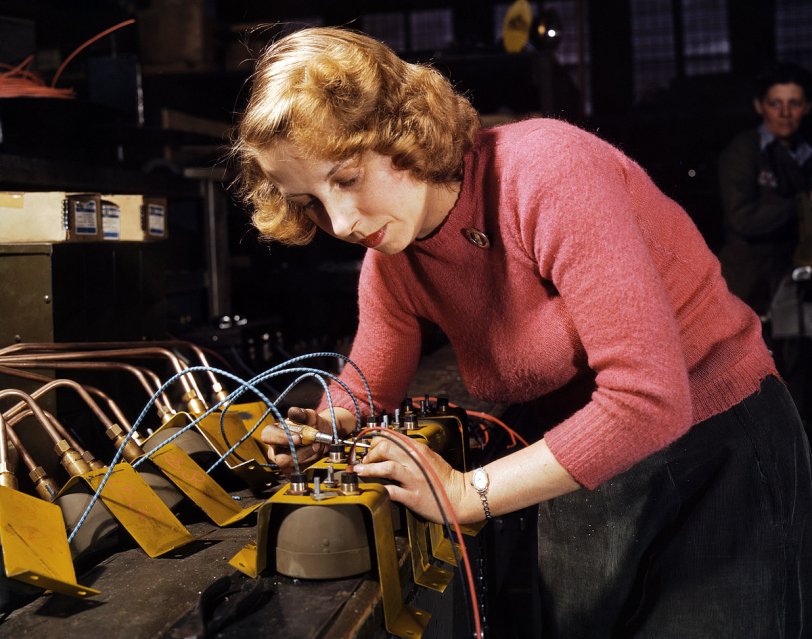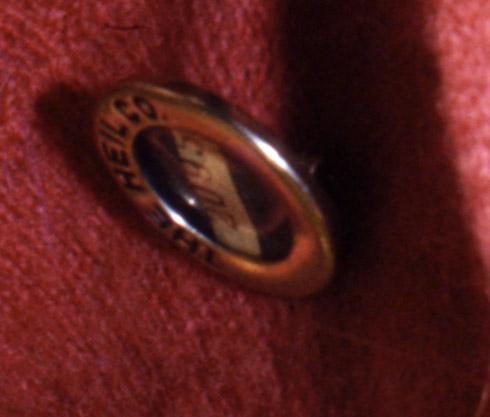


Framed or unframed, desk size to sofa size, printed by us in Arizona and Alabama since 2007. Explore now.
Shorpy is funded by you. Patreon contributors get an ad-free experience.
Learn more.

- Baldwin 62303
- Baldwin VO-1000
- Cold
- No expense spared
- Tough Guys
- Lost in Toyland
- And without gloves
- If I were a blindfolded time traveler
- Smoke Consumer Also Cooks
- Oh that stove!
- Possibly still there?
- What?!?
- $100 Reward
- Freeze Frame
- Texas Flyer wanted
- Just a Year Too Soon
- WWII -- Replacing men with women at the railroad crossing.
- Yes, Icing
- You kids drive me nuts!
- NOT An Easy Job
- I wonder
- Just add window boxes
- Icing Platform?
- Indiana Harbor Belt abides
- Freezing haze
- Corrections (for those who care)
- C&NW at Nelson
- Fallen Flags
- A dangerous job made worse
- Water Stop
Print Emporium
Lucille Mazurek: 1943

February 1943. Lucille Mazurek, age 29, ex-housewife, husband going into the service. Working at the Heil and Co. factory in Milwaukee on blackout lamps to be used on Air Force gasoline trailers. View full size. 4x5 Kodachrome transparency by Howard R. Hollem for the Office of War Information.
Re: No rings allowed
The lady's wedding ring could have been made from no softer than 18kt gold, not 24kt gold. Pure gold, as in 24kt gold, was entirely too soft to be made into wedding rings, or most all other forms of jewelry, which is why it is alloyed with other metals. This improves the strength and wearability of gold jewelry, as well as the working characteristics while being formed into jewelry. It also increases the affordability of the wedding rings, as pure gold would have been much too expensive to be affordable by most people.
Most common alloy used for wedding rings was, and still is, 14kt, as it provides the best characteristics of affordability, durability and workability. During the war years, gold wedding rings were in both high demand and decreased availability, and platinum was not available at all due to its requirements for the war industry in electronic devices. White gold was the most usual substitute, while palladium filled in some of that gap.
No rings allowed
Most factories had rules against too much jewelry, but in this case, it may have interfered with her work - she has a ring line on her finger, so I guess she took it off when working. A lot of gold bands back then were softer alloys, like 24-carat, than a lot of bands nowadays, too, so maybe she didn't want it marked up or abused.
No wedding ring.
No wedding ring. I wonder if they were required to remove them when working or is the photo reversed?
[As we can tell from Lucille's ID badge and the writing on the metal parts, the photo is not reversed. - Dave]

Lucille Mazurek 1913-1991
Mrs. Mazurek passed away in Milwaukee in 1991 according to the SSDI.
She certainly was a beautiful woman.
In the 1940s
Every woman was lovely and graceful and every man was handsome and dashing.
Heil and Company
It appears that Heil and Company started in Milwaukee in 1901 and is still in business.
http://www.heiltrailer.com/history.aspx
[Thanks Jack! If you signed up for a user account and then logged in, your comments would appear right away. - Dave]
Not the Air Force yet
Not to be too picky, but the USAF wasn't formed until 1947. That really should read "Air Corps gasoline trailers".
[Not quite. "Air Force" was short for Army Air Forces, the name of the flying service from 1941 to 1947. Before 1941 it was the Army Air Corps. - Dave]
Explosion-proof blackout lamps
I believe the conduit (tubing & fittings) was used to house the wiring and provide an explosion-proof lamp assembly. The sealed lamp wiring was necessary to prevent any potential internal ignition (such as an electrical spark) from escaping to the outside atmosphere, which for a gasoline trailer could contain explosive gas fumes.
Here is a web page that describes military blackout lamps and includes some photos.
Mike_G
Blackout lights
Been doing a little online research and have some basics. A blackout light generally put out a rectangular beam of light smaller than what a regular headlight would. In many of the examples I've seen online there was a sort of shield at the top of the rectangular beam that would keep light from spreading upward, and being visible to aircraft overhead. Some wartime jeeps had blackout lights under the regular headlights, but some models - probably made early on - had a single blackout light mounted on the driver's side fender. Presumably most military vehicles hadt to be similarly retrofitted with blackout lights. I'm just guessing, but the tubes look to be designed to protect the wiring of the retrofitted lights from water or other environmental damage from being exposed, and (probably more important on a gasoline trailer) to eliminate the possibility of sparking.
Hmmm...Quarter after five..
Must be the second shift. Anyway, my guess to Lonestar's question is that since these are blackout lamps for a gasoline trailer, the copper tubing could be used as an electric wire conduit to reduce the chance of electric sparks-copper used because it is a non-sparking metal when struck.
And to robcat2075 and Jason Martens: Y'all be careful now, that Ms Lucille looks like an Irish lass with that red hair, and you wouldn't want to go and get her mad at you...she looks like she could be a handful.
Blackout lamps
Vehicles hauling inflammable liquids typically had the wiring sealing inside metallic tubing to prevent a loose connection from arcing and igniting fumes.
Electric?
Most curious...I'd think that these would be electric lamps, but can't figure why they'd have pipe/tubing fittings on them. Any ideas?
And, Mrs. Mazurek is certainly beautiful.
Blackout lamp?
Ok, what is a blackout lamp? I imagine it is something used during blackouts, but what is it? A light with a red lens?
hmmm... the tight sweater probably didn't hurt her employment opportunities.
Penny for Your Thoughts
I would *love* to know what the lady in the corner is thinking:
"That redheaded vixen and her damn lipstick... God, I hate her..."
























On Shorpy:
Today’s Top 5